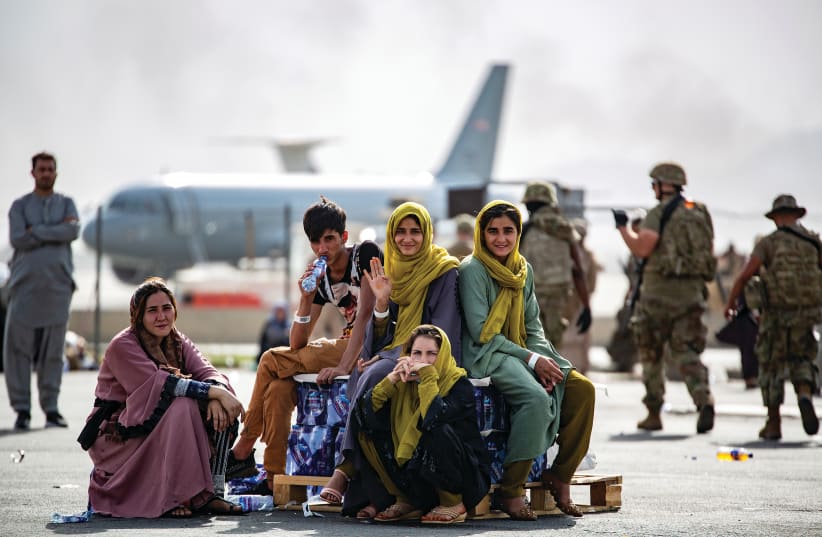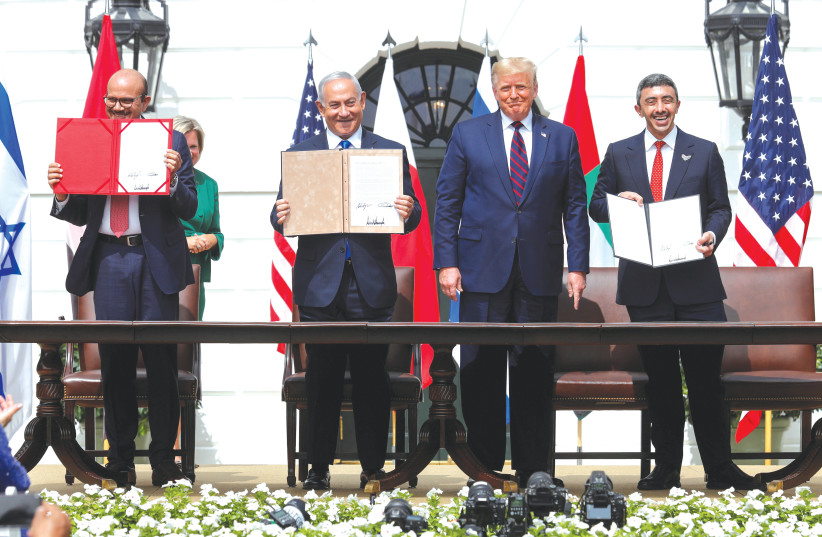As 2022 begins, the Middle East strategic picture is in a state of flux and change. Stable and long-held assumptions about the region – its dynamics, its main players and its power structures – are being challenged.
So what are the main points of friction? Here are four emergent trend lines worth watching.
In Israel, it became customary in recent years to identify a number of rival camps operating against one another in the Middle East. Four main blocs or alliances were identified.
These were: 1. the Iranians and their allies and proxies; 2. a loose gathering of US-aligned countries, including Israel, Egypt, Jordan, the United Arab Emirates, Saudi Arabia and a number of smaller players; 3. a gathering of countries and movements identified with conservative Sunni political Islam, including Turkey, Qatar, the Government of National Accord in Libya and the Hamas enclave in Gaza; and 4. the regional networks of Salafi jihadi political Islam – namely, al-Qaeda and Islamic State.
With the start of 2022, however, it is clear that this picture no longer conforms in its entirety to the observable dynamics of the region. What has changed?
THE PERCEPTION that the US is drawing down in the region is leading to cracks and fissures in the pro-Western camp.
The picture here is not a simple one. The Abraham Accords signed in August 2020 between Israel, the UAE and Bahrain were a breakthrough of profound importance for regional diplomacy. On the economic level, the accords have been a success.
Trade between Israel and the UAE moved forward at an impressive pace, standing at $610 million at the half-year point, and nudging $1 billion by the end of the year. Flagship and groundbreaking initiatives, such as the Emirati-brokered cooperation agreement between Israel and Jordan in November 2021, were made possible through the accords.
But on the strategic level, things aren’t quite so rosy. US regional drawdown is the key issue here.
The Emiratis and other Gulf countries noted in recent years the US failure to back allied governments in Egypt and Tunisia at the start of the Arab Spring; failure to enforce redlines and back allies in Syria from 2012-19; failure to respond to Iranian harassment of Emirati and Saudi vessels in the Gulf of Oman in 2019; nonresponse to the drone and missile attack on Saudi oil processing facilities at Abqaiq and Khurais on September 14, 2019, and to the downing of a US drone in June of that year.
The hasty withdrawal from Afghanistan in the summer of 2021 confirmed the picture. The US wishes to avoid further major commitments in the region.
The response of Gulf countries has been to abandon notions of a power bloc to rival the advance of the Iranians – the main anti-status quo force in the region. Instead, efforts were underway in 2021 by the UAE and Saudi Arabia to repair relations with Tehran, and thus “hedge” between Tehran and its enemies.
Israel, which also observes the process of US drawdown with concern, does not have the option of appeasing Iran. Tehran is committed to the Jewish state’s destruction. As 2022 begins, with negotiations over Iran’s nuclear program going nowhere in Vienna, the emerging picture is one in which Israel is somewhat isolated as it prepares a possible military option against Iran’s nuclear program, and continues its shadow war against Iranian influence building across the region.
Will this solitude continue across the coming year, or will the Gulf countries, disappointed in their overtures toward Iran, form up with Israel for confrontation with Tehran?
The issue has relevance for Syria, too, where Israel’s campaign against Iranian advances continues, even as the major Arab countries seek the rehabilitation of the Assad regime.
This is one of the major questions now facing the Mideast.
THE IRANIANS are facing dilemmas of their own.
The years 2020 and 2021 showed the limits of the IRGC/Quds Force’s model for building influence through proxies in the Arab world.
Iran’s militia franchises remained dominant in Lebanon, ascendant in Iraq and active on the ground in Syria and Yemen. But the results of the presence of these militias for social and economic development were also becoming apparent.
In Lebanon, the withdrawal of economic engagement as a result of Hezbollah’s domination of public life is bringing the country close to collapse.
Iraq, and Iran itself, in Isfahan and elsewhere, witnessed major protests against economic mismanagement and impoverishment over the last year.
Iran has no economic model to propose, and no clear answer to the identifiable economic decline and disruption that its political model brings.
Will this lead to further protests and instability in the Iranian zones of influence in 2022? Worth watching carefully.
FOR THE Salafi jihadis, it has been a lean couple of years.
The “caliphate” in Syria and Iraq is already a fading memory – destroyed by US airpower and Kurdish and Iraqi ground forces in 2019. ISIS remains a disruptive presence in remote Sunni areas of both countries, but little more.
The erstwhile al-Qaeda franchise in Syria, meanwhile, has been co-opted by the Turks and is today dependent on their presence for its survival.
But the West’s withdrawal from Afghanistan may offer a glimmer of hope to the Salafists. Taliban rule in Kabul opens up the possibility of a new center for recruitment, organization and planning for both al-Qaeda and, in particular, Islamic State.
The latter maintains a powerful franchise in Afghanistan, known as Islamic State – Khorasan Province, or IS-K. This structure is currently engaged in a campaign of daily bombings and attacks against the Taliban authorities. It now has a presence in all of Afghanistan’s provinces.
Testifying to the US Congress in late October 2021, Colin Kahl, undersecretary of defense for policy, predicted that IS-K could develop the capacity for carrying out attacks on foreign targets within “six or 12 months.”
Large and disaffected Sunni populations remain in the important countries of the Arab world. Political Islam has been tarnished over the last decade by its disastrous experiences in government in Egypt, and as a quasi state in parts of Iraq and Syria. At the same time, no rival ideology has emerged to replace it on the popular level.
Afghanistan’s reemergence as a possible incubator for a revived transnational-terrorist force is a significant development.
LASTLY, AND perhaps most fatefully, the question of China and its preferred path in the Middle East looms over the region.
Geopolitics abhors a vacuum. As the US lightens its regional footprint, China is emerging as an increasingly significant source of power and influence in the Middle East. The region is a vital hub in Xi Jinping’s Belt and Road Initiative, intended to create a series of interlinked, China-dominated trade routes across the globe.
The question is: what form will Chinese regional engagement take? Will Beijing continue to trade with all sides, confident that its size and power precludes the need for picking allies among the competing elements? Or will the emergent US-China Cold War find its way inevitably into the Middle East, too?
There is no definitive answer yet. Iran, Saudi Arabia, Israel and the UAE all enjoy burgeoning trade relationships with Beijing. A new terminal at Haifa Port, operated by the state-owned Shanghai International Port Group, was inaugurated in September 2021.
But there are warning signs on the horizon, too – 2021 saw Iran gaining approval for its full membership in the Shanghai Cooperation Organization. On March 27, 2021, China and Iran signed a 25-year strategic agreement, intended to lead to $400b. of Chinese investment in the Iranian economy.
In Israel, the emerging area of deep concern is increased military cooperation between Iran and China.
In a recent article published at the INSS think tank in Tel Aviv, Brig.-Gen. (ret.) Assaf Orion noted: “The strategic agreement between China and Iran, to the extent that the draft reflects the final version, outlines a zone of agreement on cooperation in intelligence, cyberwarfare, precision navigation systems, weapons research and development and military training and instruction.”
Orion described this prospect as “alarming” for Israel. This trend, too, is one to carefully watch in 2022.
The global strategic pillars are currently in motion. Will the coming period bring renewed equilibrium or further crisis? An interesting year lies ahead for the Middle East.

